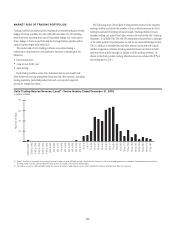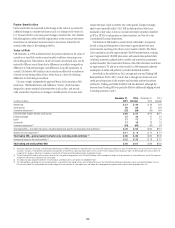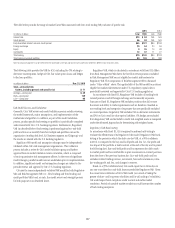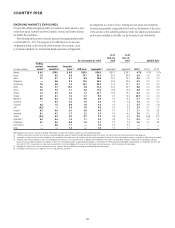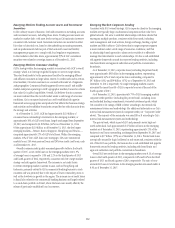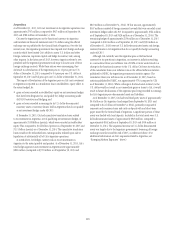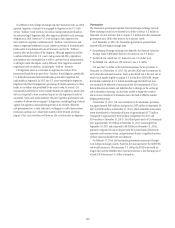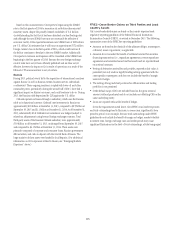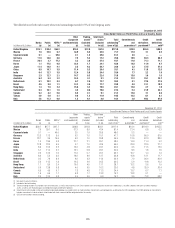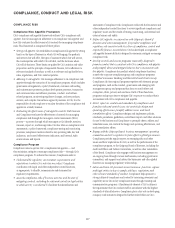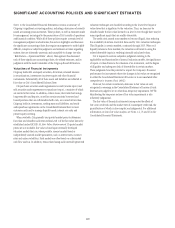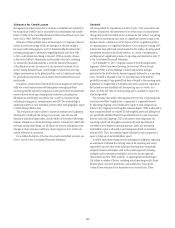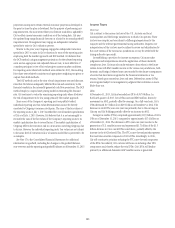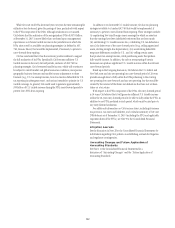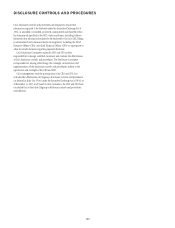Citibank 2015 Annual Report Download - page 132
Download and view the complete annual report
Please find page 132 of the 2015 Citibank annual report below. You can navigate through the pages in the report by either clicking on the pages listed below, or by using the keyword search tool below to find specific information within the annual report.114
In addition to these foreign exchange and other economic risks, as widely
reported, Argentina continues to be engaged in litigation in the U.S. with
certain “holdout” bond investors who did not accept restructured bonds in
the restructuring of Argentine debt after Argentina defaulted on its sovereign
obligations in 2001. Based on U.S. court rulings to date, Argentina has
been ordered to negotiate a settlement with “holdout” bond investors and,
absent a negotiated settlement, not pay interest on certain of its restructured
bonds unless it simultaneously pays all amounts owed to the “holdout”
investors that are the subject of the litigation. Although Argentina has been
in technical default of the U.S. court’s ruling since mid-2014, Argentina’s
new president has announced that it will be a priority for his administration
to attempt to settle the dispute, and in February 2016, Argentina restarted
negotiations with its creditors, including the “holdout” investors.
Citi Argentina acted as a custodian in Argentina for certain of the
restructured bonds that are part of the “holdout” bond litigation; specifically,
U.S.-dollar-denominated restructured bonds governed by Argentine law
and payable in Argentina. In 2015, the U.S. court overseeing the Argentina
litigation ruled that Citi Argentina’s processing of interest payments on these
bonds, as custodian, was prohibited by the court’s order. As a result, Citi
announced its intention to exit its custody business in Argentina, which such
exit is not expected to have a material impact on Citi Argentina’s results of
operations. Upon such announcement, the prior Argentine government took
a number of adverse actions against Citi Argentina, including filing a lawsuit
against Citi Argentina and suspending certain of its activities. While the
new government has, to date, indicated a willingness to settle these matters,
it remains uncertain as to when these matters will be resolved and what
impact, if any, such resolution will have on Citi or its franchise in Argentina.
Venezuela
The Venezuelan government operates restrictive foreign exchange controls.
These exchange controls have limited Citi’s ability to obtain U.S. dollars in
Venezuela; Citi has not been able to acquire U.S. dollars from the Venezuelan
government since 2008, other than for its customers’ needs.
As of December 31, 2015, the Venezuelan government operated three
separate official foreign exchange rates:
• the preferential foreign exchange rate offered by the National Center for
Foreign Trade (CENCOEX), fixed at 6.3 bolivars to one U.S. dollar;
• the SICAD rate, which was 13.5 bolivars to one U.S. dollar; and
• the SIMADI rate, which was 199 bolivars to one U.S. dollar.
Citi uses the U.S. dollar as the functional currency for its operations in
Venezuela. As of December 31, 2015, Citi uses the SICAD rate to remeasure its
net bolivar-denominated monetary assets as the SICAD rate is the only rate at
which Citi is legally eligible to acquire U.S. dollars from CENCOEX, despite
the limited availability of U.S. dollars and although the SICAD rate may
not necessarily be reflective of economic reality. Re-measurement of Citi’s
bolivar-denominated assets and liabilities due to changes in the exchange
rate is recorded in earnings. Citi has been unable to hedge the currency
risk in its net investment in Venezuela due to the lack of effective market
hedging mechanisms.
At December 31, 2015, Citi’s net investment in its Venezuelan operations
was approximately $200 million (compared to $187 million at September 30,
2015 and $180 million at December 31, 2014), which included net monetary
assets denominated in Venezuelan bolivars of approximately $177 million
(compared to approximately $160 million at September 30, 2015 and
$140 million at December 31, 2014). Total third-party assets of Citi Venezuela
were approximately $1.0 billion at December 31, 2015 (unchanged from
September 30, 2015 and compared to $0.9 billion at December 31, 2014),
primarily composed of cash on deposit with the Central Bank of Venezuela,
corporate and consumer loans, and government bonds. A significant portion
of these assets was funded with local deposits.
On February 17, 2016, the Venezuelan government announced changes
to its foreign exchange controls. Based on the announcement, the CENCOEX
rate would increase to 10 bolivars per U.S. dollar, the SICAD rate would no
longer exist and the SIMADI rate is expected to become a free floating rate of
at least 202 bolivars per U.S. dollar at inception.



